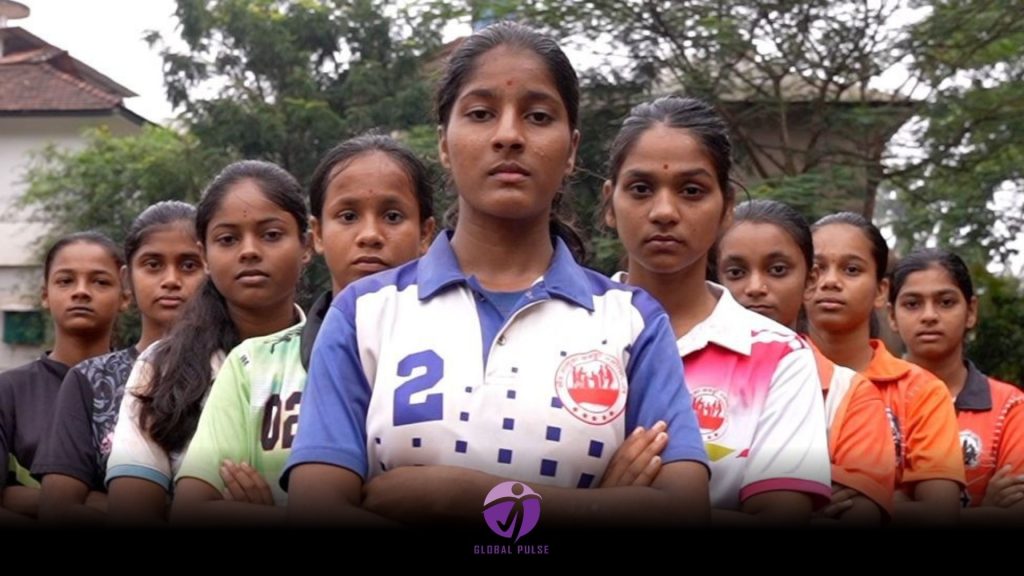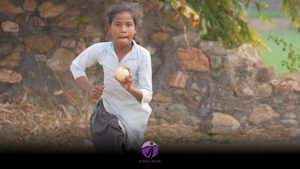Meena’s gaze shifts rapidly from side to side, keenly anticipating the precise instant to seize her opportunity.
She participates in Kabaddi, a contact sport from India that has gained popularity and is now played in over 50 countries worldwide.
Kabaddi involves a contest between two teams, each consisting of seven players. Participants alternate in a dynamic sprint into the opposing team’s territory, aiming to tag their rivals while evading tackles and returning safely to their half of the field.
For 14-year-old Meena, the stakes extend beyond mere points on the scoreboard. The sport provides a means of liberation from the confines of rural existence, unveiling a realm of possibilities.
“It feels different when I play,” she admits, her voice tinged with shyness as she searches for the right words. At that moment, I transcend the identity of Meena, no longer confined by the burdens of household duties and societal pressures. It is solely me facing off against my opponent… “I feel a sense of empowerment that sets me apart from girls who do not engage in the game.”
Meena lives on the periphery of Kudoshi, a small tribal village approximately 230 kilometres from Mumbai, India’s financial hub. In this community, girls’ lives are traditionally centred around domestic responsibilities, marriage, and raising children.
Fifteen years ago, a collective of educators at the village school took a significant step towards enhancing opportunities for girls.
I am the parent of a daughter. “I want her to achieve great things in life, to live her best life, and to become someone significant,” states Daji Rajguru. “What barriers prevent girls from participating in Kabaddi and pursuing it as a viable career?”
To empower local girls, he and his colleagues, who have a background in playing Kabaddi during their youth, decided to share their knowledge of the sport. They combined their savings of 5,000 rupees ($60; £50), successfully convincing the school to grant access to its grounds, and established what they believe to be the first all-girls Kabaddi club in the region.
Initially, only two girls, both students at the school, came together to form the group. “He notes that parents were hesitant to allow their daughters to participate in Kabaddi, citing concerns about the significant time spent away from home.” Concerns arose regarding the potential effects on their daughter’s marriage prospects, particularly as traditional families often disapprove of young women returning home late after outings.
Daji and his team visited homes to reassure parents about the safety of their daughters during Kabaddi training sessions held before and after school. Their assurances emphasized a commitment to properly supervising the girls and minimizing distractions from boys.
Initially, teachers provided transportation for the girls, picking them up from their homes and dropping them off. However, as enrolment increased, this practice became unfeasible. The club currently boasts approximately 30 girls, with estimates suggesting that around 300 have participated in training sessions since the coaching program’s inception, notably including Daji’s daughter. Many individuals begin their journey in this activity at the tender age of seven.
Meena, along with her fellow club members, dedicates two hours to training before school and another two hours after classes conclude. She departs from home at dawn and returns only after nightfall.
“I venture out alone into the darkness of the early morning.” I once harbored fears that someone might pose a threat to my safety. “My family was not supportive at the time, and they continue to express their dissatisfaction with my decision to pursue a career as a sportswoman,” she states.
She continues to push forward, drawing motivation from club members who have achieved success over the years, earning spots on state teams or participating in local leagues. Siddhi Chalke and Samreen Burandkar were part of the inaugural group of girls who underwent training at the club for approximately eight years. At just 25 years old, they have established themselves as professional league players and achieved financial independence.
Initially, families believed that the interest in Kabaddi would be fleeting. However, when the women chose to pursue it as a career, their parents expressed dissatisfaction. Despite ongoing pressure for marriage, the families expressed pride in the women’s achievements and successes.
“No one in my family earns as much as I do,” Samreen states. Residing in a bustling metropolis, I can make my own decisions. In my community, girls face significant challenges when pursuing their aspirations. “I am only here because of Kabaddi,” she states.
Siddhi and Samreen share a bond forged through their time on the same Kabaddi team. Their journey across India has been marked by participation in various competitions, where they have secured numerous medals and championships. “My ability to achieve that was solely due to Kabaddi.” “Otherwise, I would have been married and ended up at my husband’s place washing the dishes,” Siddhi remarks, prompting laughter from both as they express a sense of relief at having avoided such a fate.
Achieving success in sports within India can provide athletes with opportunities for employment in the public sector. Indian states are implementing job allocations for high achievers in sports, ensuring a stable income for athletes beyond their competitive careers.
In rural areas, numerous girls are pursuing sports with aspirations of achieving financial independence through these career opportunities. This approach may enhance their respect and foster a stronger sense of identity.
At the sports club’s inception, the contributions and potential of these girls were largely overlooked. “In their homes and society, they have always been treated as secondary citizens,” states Vilas Bendre, a young coach at the club.
It became evident that their circumstances transformed remarkably when rural girls advanced through sports. While not all club members have transitioned into professional sportswomen, many have experienced a significant boost in confidence. This newfound self-assurance has empowered them to advocate for their education, encouraging their families to support their pursuit of university and postpone marriage until a later age.
The community has shown a notable shift towards greater acceptance, as evidenced by the changing attitudes towards girls who engage in exercise. Fewer individuals express disapproval.
The club’s financial support comes from its coaches, cash prizes earned through competition victories, and sporadic donations. Most girls come from economically disadvantaged backgrounds and are exempt from paying subscription fees.
The club conducts training during the academic year and organizes and finances residential sports camps at the school over the summer. It also supplies food items like eggs, bananas, and milk and frequently covers the costs associated with treating players’ injuries.
As time has progressed, parents’ concerns have diminished; however, there are still critics who raise questions about the coaches’ intentions. “Individuals often indirectly express their thoughts.” “Why don’t you coach boys?” Daji enquires. He asserts that while opportunities exist for boys, there remains a significant gap regarding those available for girls.
“We play a role beyond that of mere coaches,” adds Vilas. “There are moments when we assume the role of parents, providing guidance, enforcing discipline, and assisting them in making the right decisions.”
Meena is acutely aware of the significance of this coveted opportunity. “I want to be the best raider and become the captain of India’s Kabaddi team,” she declares, expressing her aspirations for medals, championships, and a future that transcends her ordinary village upbringing.













